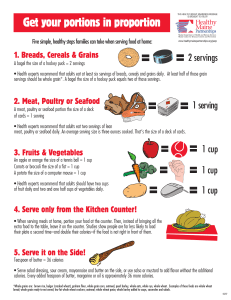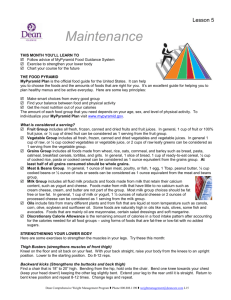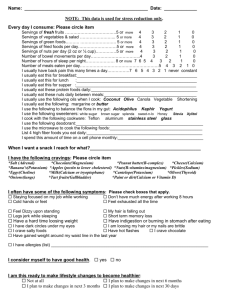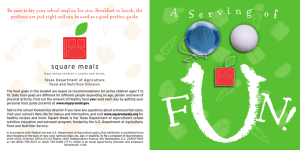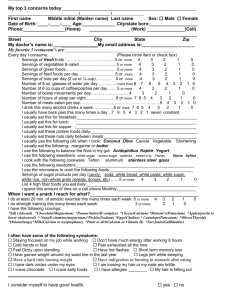Food Smart: Your Guide
advertisement
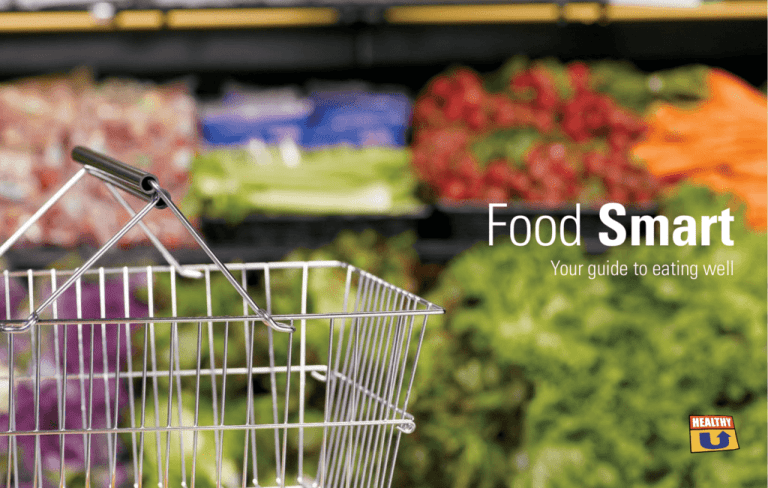
Food Smart Your guide to eating well Welcome to your guide to healthy eating Food is important to all of us. Eating food gives us pleasure Children learn from their parents. Your children will copy your and provides our bodies with the fuel it needs to stay alive. eating habits. This booklet teaches you about healthy eating When we make smart food choices, we help keep our body choices for adults and children over the age of two so that strong and healthy. you and your family can enjoy a healthy life. Food can also make us unhealthy if we eat the wrong kinds Don’t forget that eating well is only one part of healthy living. of food or eat too much. This booklet will help you figure out Keeping your body active is important as well. Eating the how to buy, cook and eat healthy food. You will learn about: right amount of healthy foods and being active every day is a good way to keep your body healthy. • Eating Well with Canada’s Food Guide. • Healthy food choices from the four food groups. • Eating enough from each food group every day. • Healthy serving sizes. • Meal planning and food shopping. For more information on healthy eating and active living go to • How to read nutrition labels on the foods you buy. www.healthyalberta.com Contents Welcome to your guide to healthy eating i Understanding food terms and measurements 1 Using Canada’s Food Guide 5 How much food is enough? 13 Food check-up: how well are you eating? 23 Planning your meals 25 Healthy shopping: eating well and saving time and money 33 Understanding package labels 39 Staying safe while eating healthy 41 Recipes on the Internet 43 ii Understanding food terms and measurements Your food smart dictionary Use these pages to help you understand words Measurements in this booklet. When these words and short forms are used, this is what they mean: tsp = teaspoon tbsp = tablespoon (larger than a teaspoon) L = litre mL = millilitre (1,000 millilitres equals 1 litre) CFG serving =The amount of a food considered to be a single serving by Eating Well with Canada’s Food Guide (CFG). % Daily Value = The amount of a nutrient (like vitamin C) that is in a food compared to how much of that nutrient an average person needs each day. Weights oz = ounce lb = pound g = gram kg = kilogram (1,000 grams equals 1 kilogram) Food terms Saturated fat Trans fat =A solid fat that makes unhealthy fats in your body. =Similar to saturated fat, but usually made artificially. Trans fat can be found naturally in small amounts in milk and some meat, but most of the trans fats we eat come from manufactured (processed) foods. Unsaturated fat =Sometimes called monounsaturated or polyunsaturated fats, these types of fats are healthy fats. Unsaturated fat is found in olive and canola oil, flax seeds, peanuts, avocados, fish, seafood, nuts and sunflower seeds. Non-hydrogenated margarine =A healthy margarine/fat choice because it is not made with hydrogenated oil. =Includes starch, sugar and fibre. Carbohydrates are nutrients found in grains, vegetables, fruits and Carbohydrate milk products. Fibre Protein =A material found in plant foods. It helps food move all the way through your digestive system. =A material found in meats and meat alternatives such as eggs, lentils and nuts. It helps build many parts of the body, including muscle, bone, skin and blood. Sodium =A mineral found in our soil (dirt). It is used in table salt and packaged foods. Our bodies need a little bit of sodium, but too much is not healthy. Understanding food terms and measurements Your food smart pictionary 1 tbsp or 15 mL 1 tsp or 5 mL 1/2 tsp or 2.5 mL 1/4 tsp or 1 mL Measuring spoons Thermos – Keeps food hot. or Tablespoon Freezer pack – Keeps food cold. Teaspoon 3/4 cup or 175 mL 1/4 cup or 60 mL 1/3 cup or 80 mL 1 cup or 250 mL 1/2 cup or 125 mL Wet ingredient measuring cup Dry ingredient measuring cups Eating Well with Canada’s Food Guide describes four food groups For each food group, Canada’s Food Guide recommends healthy food choices and serving sizes for Vegetables and Fruit Grain Products adults and children over the age Examples of healthy choices are: Examples of healthy choices are: Vegetables: carrots, peas, Pasta, rice, cereals, breads, green and yellow beans, beets, naan, roti, pita pocket, bun, cabbage, broccoli, bok choi, bannock, sub bun, bagel, onions and radishes. steam bun and couscous. Using Canada’s Food Guide of two. Tip •C anned, cooked, sliced, diced, fresh, frozen or dried, vegetables and fruit are all good for you! Tip • Choose whole grains. Fruit: tomatoes, apples, oranges, bananas, berries, pears, mangos, kiwis and lichies. Tip • Make low-fat choices. Milk and Alternatives Meat and Alternatives Examples of healthy choices are: Examples of healthy choices are: Milk (2%, 1%, skim), yogurt Beef (hamburger), chicken, turkey, (plain and low fat), hard cheese wild game, pork (ham), lamb, fish, (cheddar and mozzarella) and eggs, beans (kidney beans, pinto fortified soy beverage. beans, chick peas, black beans, For more choices refer to Eating Well with Canada’s Food Guide. soy beans) and lentils (red, brown, green, orange). If you do not have access to the Internet you can pick up a copy of the food guide at your local community health centre. How to follow Canada’s Food Guide Using Canada’s Food Guide How much should you eat? The amount you need to eat to be healthy Depending on your age, an example of a meal depends on: plan for people who sit all day and do not • your age exercise includes: • how active you are • at least 5 servings of Vegetables and Fruit; • your height and weight • whether you are male or female • at least 5 servings of Grain Products; • if you are pregnant or breastfeeding • at least 2 servings of Milk and Alternatives; and, Canada’s Food Guide gives advice for anyone over two years old. Use Canada’s Food Guide for general advice. • at least 2 servings of Meat and Alternatives. The next few pages show examples of meals used in this plan. Watch how the daily servings add up with each meal. Morning meal Grain Products 1 serving: •3 /4 cup or 175 mL shredded wheat cereal Vegetables and Fruit 1 serving of fruit: • 1/2 cup or 125 mL fruit juice Milk and Alternatives 1 serving: • 1 cup or 250 mL of milk Total servings for the day 1 2 3 4 5 Vegetables and Fruit Grain Products Milk and Alternatives Meat and Alternatives Midday meal Meat and Alternatives Using Canada’s Food Guide 1 serving: •2 to 3 oz or 50 to 76 g of tuna fish Milk and Alternatives Grain Products 1 serving: • 1 cup or 250 mL of milk 2 servings: •2 halves of a whole wheat pita Total servings for the day Vegetables and Fruit Grain Products Milk and Alternatives Meat and Alternatives Vegetables and Fruit 1 2 3 4 5 1 serving of vegetables: •1 /2 cup or 125 mL carrot sticks and shredded lettuce 1 serving of fruit: • 1 small apple Evening meal Milk and Alternatives 1 serving: • 1 cup or 250 mL of milk Meat and Alternatives Grain Products 1 serving: •3 /4 cup or 175 mL of baked beans 2 servings: •1 cup or 250 mL of cooked rice Vegetables and Fruit 1 serving: •1 /2 cup or 125 mL of broccoli Total servings for the day 1 2 3 4 5 Vegetables and Fruit Grain Products Milk and Alternatives Meat and Alternatives 10 Snack Age and activity level affects how much you should eat. The table on the right will help you figure out what amounts are healthy for you each day. Young children age two years to five years need child-size servings which are half to one serving suggested in Using Canada’s Food Guide Canada’s Food Guide. 11 Vegetables and Fruit 1 serving: •1 /2 cup or 125 mL of sliced pear Total servings for the day Vegetables and Fruit Grain Products Milk and Alternatives Meat and Alternatives Tip 1 2 3 4 5 Children, depending on their age and activity level, need healthy small snacks between meals. Canada’s Food Guide recommended daily servings Vegetables and Fruit Grain Products Milk and Alternatives Meat and Alternatives 4 – 5 servings 3 – 4 servings 2 servings 1 serving 6 – 7 servings 5 servings 2 – 3 servings 2 – 3 servings Teenagers 7 – 8 servings 6 – 7 servings 3 – 4 servings 2 – 3 servings Adults who get 7 – 8 servings 6 – 7 servings 2 servings 2 – 3 servings 7 – 9 servings 6 – 8 servings 2 servings 2 – 3 servings Young children 2 – 8 years Adults and seniors who sit most of the day and do not exercise, and those who need to lose weight daily activity Pregnant and breastfeeding women* * Pregnant and breastfeeding women need more calories, therefore they include an extra 2 to 3 CFG servings each day. 12 Are you eating too much food? A healthy serving is a Canada’s Food Guide serving. The size of that serving depends on the type of food you are eating. Some foods count as more than one serving. You should make Grain Products Here are some examples of what one serving of grains from CFG is: sure you know how many servings are in the Bread Naan Pita How much food is enough? food you eat, so that you can avoid eating more 13 than your body needs. Eating more can cause you to gain weight. Whole grains are a good source = 1 slice Dry cereal = 1/2 naan Granola-type cereal = 1/2 pita Oatmeal of fibre, vitamins and minerals. What kind of whole grains do you like to eat? Have you tried barley, brown rice, oats, quinoa and wild rice? cup =or 1250 mL = or1/380cup mL = or3/4175cupmL cooked 6” sub bun Large store-bought or fast-food bagel to 5 =CFG4servings 1/2 bun Rice = 1/2 cup or 125 mL cooked 3 CFG = servings Store-bought foods may Bun = 6” diameter pita or naan or roti contain several Canada’s Food Guide servings. Store-bought or fast-food muffin Pasta = Some cereal bowls are large enough to hold 1/2 cup or 125 mL cooked 2 CFG = servings 4 CFG servings of cereal to 3 =CFG2servings 14 Canned, cooked, sliced or diced Vegetables and Fruit Here are some examples of what Whole fruit e.g. (1) apple or (1) orange one serving of fruit or vegetables from CFG is: Dried fruit How much food is enough? = or1/2125cupmL 15 = =or1/460cup mL 100% Juice about the size of 1 tennis ball Juice box 100% Juice - 250 mL Tip •C hoose canned vegetables with little or no added salt. •C hoose canned fruit that is packaged with no added sugar. =or1/2125cupmL = 2 servings Try to limit 100% juice to 1/2 cup (125 mL) per day, which is only 1/2 of a juice box. Have vegetables and fruit more often than juice. Tip Make sure the juices you buy are 100% juice. What you buy in the store is bigger than you think Fruit drinks, fruit-ades (like lemonade), fruit punches, beverages and cocktails are mostly sugar and water. Make a fruit salad by cutting up: = = = 1 apple + 1 banana + 1 orange + 1 pear = 10 servings Most fruit you buy in the store is larger than the tennis ball size serving. (1/2 cup or 125 mL each) CFG serving 16 Milk and Alternatives Here are some examples of what Yogurt (plain and low-fat) one serving of milk or alternatives from CFG is: Fluid milk or fortified soy beverages, low-fat How much food is enough? = or3/4175cup mL 17 = 1 cup or 250 mL Cheese slices (store-bought) Hard cheese (eg. cheddar and mozzarella) = 50 g or length of thumb = 2 slices Did you know… Your body needs calcium to make bones, teeth and muscles strong. Vitamin D helps your body absorb the calcium from milk and fortified soy beverages. To make vitamin D, your body needs sunlight, but during the winter Canada doesn’t get enough sunlight Did you know… Drinking milk with meals and water to quench thirst is a healthy habit. You can save money and avoid a lot of extra sugar by not buying pop or fruit-flavoured drinks. for you to make all the vitamin D you need. That’s why vitamin D is already added to milk and fortified soy beverages. 18 Meat and Alternatives Here are some examples of Eggs (small) Nut butters what one serving of meat or alternatives from CFG is: How much food is enough? Meat, fish, poultry 19 = 1 to 2 eggs =or250toto3 oz 75 g or size of palm of hand =or115toto2 tbsp 30 mL Tofu Beans, lentils and legumes (eg. black beans, chick peas, split peas) =or1/375cup mL cup =or1/2125cupmL toor 1250 mL How to calculate the number of servings in a package of raw meat. 1. Find the weight listed on the package. Is it in kilograms (kg) or grams (g)? a. If it is kilograms (kg), you will need to calculate the weight into grams. Go to step 2. b. If it is in grams, go to step 3. 2. Calculate the weight in grams. Multiply the weight in kilograms by 1,000. 3. Calculate the number of servings in the package. A serving for one person is about 80 grams of uncooked meat. Divide the weight of the package (in grams) by 80. Tip Example: 1. This package of meat says the weight is 0.400 kg. 2. 0.400 kg x 1,000 = 400 grams 3. 400 ÷ 80 = 5 servings Lean and skinless meats are healthy So the package contains 5 CFG servings of meat. choices. Regular meats might have a Note: If the meat in the package has bones, then a serving lower price, but you may be paying for skin and fat that you would probably cut off and throw away at home. size is 85 grams. Divide the weight of the package by 85 instead of 80. 20 Is sugar bad for me? Sugar is a source of energy found naturally in foods like sugar cereals are unhealthy choices because they contain vegetables, fruits and milk products. These foods are healthy too much sugar and very few other nutrients. If you do eat sources of sugar because they also contain important these foods, make one choice and have it only once a week. vitamins and minerals. Foods with added sugar in them, Always remember to brush your teeth after eating to protect like pop, chocolate bars, hard candies, ice cream, cakes and your teeth from cavities. How much food is enough? Did you know… 21 A large bowl full of sugar sweetened cereal (4 servings) has just as much sugar as one can of pop! Would you serve your child a can of pop for breakfast? = = 10 tsp of sugar 10 tsp of sugar 10 tsp of sugar Is salt bad for me? Is fat bad for me? Your body needs only a small amount of salt, also called sodium. Fat is found naturally in foods like meats, nuts, some plants, Small amounts of sodium are found naturally in almost all foods. and milk products. But your body only needs a small amount If you make healthy food choices daily, you will provide your of fat to keep it healthy. When adding fatty ingredients like body with all the sodium it needs. Foods that come in packages butter, margarine or oil to your foods, use small amounts contain added sodium to prevent the food from spoiling on the and look for foods that only have healthy fats. Saturated fat shelf. Eating a lot of packaged foods can give your body too much and trans fat are unhealthy fats. Monounsaturated fat and sodium, which can cause problems like high blood pressure. polyunsaturated fat are better choices. What about water? If you are thirsty, have a drink of water. In Canada the water that comes from the tap is safe to drink. You already pay monthly for the water from the tap. You do not need to spend extra money on bottled water. When you move to a new place to live, you can phone your community health centre and ask if there are any water warnings. F ats like oil, butter, margarine, mayonnaise and salad dressings add flavour to foods but eating too much can make you gain weight. Foods like cakes, pies, chocolate bars, doughnuts, potato chips and french fries are very high in fat and are not good choices for your body. If you use bottled water to make baby milk, you must boil the water first. 22 Food check-up: how well are you eating? Healthy eating checklist 23 Look at the quiz on the next page. Can you answer “yes” to most or all of these questions? If you can, congratulations. You are eating healthy. If not, this is a good time to think about the changes you can make to eat healthy. 24 Plan your meals using a weekly menu Save time and money by planning Plan your evening meal first. a week of meals before you go grocery shopping. With a plan, you will buy fewer food items that you Step 1 Choose the meal. What is the meat or alternative? Step 2 Choose the vegetable. Step 3 Choose the grains. Step 4 Choose the milk product or fortified soy beverage. don’t need and make fewer trips to the store. Here’s what you’ll need: • a copy of Canada’s Food Planning your meals Guide, 25 • recipes that you and your family like to eat, and • a piece of paper divided into a table like the one to the right. This is an activity the whole family can do together. Now you have evening meals planned for a week using all four food groups! Next, plan your morning and midday meals by following the same easy steps. Tip When you are planning your evening meals make sure to plan for extra servings. You can use the leftovers for lunch the next day. Don’t forget to include a piece of fruit for lunch. 26 Packing healthy lunches Lunch idea #1 Lunches should include at least one choice from each of the four food groups. Here are some ideas if you do not have leftovers to use. Vegetables and Fruit Planning your meals •1 27 apple Milk and Alternatives •2 Grain Products cheese slices Meat and Alternatives • 75 g of sliced meat •2 slices of whole wheat bread Lunch idea #2 Milk and Alternatives •1 cup or 250 mL of 1% chocolate milk Vegetables and Fruit • 1/4 Grain Products •1 whole wheat tortilla wrap • 1/4 cup or 60 mL of rice cup or 60 mL of shredded carrot •2 tbsp or 30 mL of diced celery • 1/2 cup or 125 ml of sliced canteloupe Meat and Alternatives • 1/2 cup or 125 mL of beans 28 Lunch idea #3 Grain Products long whole wheat sub bun Planning your meals •4 ” 29 Vegetables and Fruit • l ettuce and tomato slices Meat and Alternatives • 75 g of sliced turkey meat Milk and Alternatives • 1 cup or 250 mL of 1% or skim milk • 1 /2 cup or 125 mL of grapes Here are some more lunch ideas to choose from: Vegetables and Fruit • Celery sticks Grain Products • Whole wheat pita •C heese string (1 stick) • Banana • Carrot sticks Milk and Alternatives • Whole wheat bun • Milk—1% or skim Meat and Alternatives •S crambled eggs (for pita) • Tuna salad • Apple •C ut vegetables If you don’t have a thermos or small freezer pack, it is hard to pack cold milk for • Noodles with dip •Y ogurt—plain or • Meatballs and sauce low-fat children’s lunches. Pack a water bottle instead. Your child can have a glass of milk • Peach • Honeydew melon balls Tip or fortified soy beverage as •P izza shell (individual—6”) • F ortified soy beverage •H am or chicken (topping for pizza) an after school snack. 30 Remember to eat a morning meal Breakfast idea #1 Meat and Alternatives Eating in the morning is very important. Your body needs the energy from food to work well each day. Your children will also •1 tbsp of peanut butter Grain Products •1 slice of toast do better in school if they eat in the morning. You can eat just about any food for breakfast, but try to use foods from at least Planning your meals three of the four food groups. 31 Another breakfast idea •R ice with beans, fortified soy beverage and melon slices Milk and Alternatives Vegetables and Fruit •1 medium orange •1 cup or 250 mL of milk Breakfast idea #2 Breakfast idea #3 Vegetables and Fruit Vegetables and Fruit •1 /2 cup or 125 mL of 100% juice • 1/2 cup or 125 mL of fruit Grain Products •3 /4 cup or 175 mL of cereal Milk and Alternatives Grain Products •3 /4 cup or 175 mL of cereal •1 cup or 250 mL of milk Milk and Alternatives • 3/4 cup or 175 mL of yogurt 32 Healthy shopping: eating well and saving time and money 33 Foods to keep in your cupboard This picture shows some foods that will last a long time and that you will use often. Keeping them in your cupboard saves time and money (you can buy them in bulk or on sale without worrying that they will spoil). These are foods you should keep in buying a few of these foods with each shopping trip. your fridge: • Milk • Only buy the foods and spices that you and your family will eat. • Cut vegetables (carrots, celery) ready to eat in a container • Use discount food coupons from newspapers and flyers to make your food budget go farther. • Eggs • Cheese • Build up your cupboard supplies by • Make sure to store these foods in airtight containers to make them last even longer. 34 Healthy shopping: eating well and saving time and money 35 Buying food for a recipe 1 kg of rice Sometimes it is hard to know how much of an ingredient you need to buy for a recipe. Here is a guide to help you. or 1500 mL = 6 cups uncooked rice Tip •H elp your children make healthy choices. Keep healthy snacks in your cupboard instead of pop, chips and candy. (12 cups or 3000 mL cooked rice) 450 g of pasta If unhealthy foods are not in your cupboard, your children will learn to choose healthy snacks. •P romote healthy habits. Reward your children with non-food rewards such as extra story reading. Or find something fun and active to do with them. Play outside with them or go swimming together. Go for a walk or play in the snow. or 1000 mL = of4 cups uncooked pasta 1/2 cup uncooked rice or 250 mL = 1 cup cooked rice 1 kg of sugar or 875 mL = 4 1/2 cups of sugar 450 g of spaghetti 1 kg of flour cups or 1500 mL = 6cooked spaghetti = 9 cups or 2250 mL of flour 1 kg of brown sugar or 1250 mL = 5 ofcups brown sugar 450 g of cheese or 1000 mL = 4ofcups grated cheese 1 L of milk 1000 mL = 4 cupsoformilk 450 g of non-hydrogenated margarine cups or 500 mL =of2non-hydrogenated margarine 36 Healthy shopping: eating well and saving time and money 37 How can I shop for healthy food and stay within my budget? Writing a list before you go to the grocery store helps you shop better. Keep looking at your list so you buy only what you need. Step 1 Notice how your grocery store is set up. Most grocery stores put healthy choices from the four food groups on the outside edges of the grocery store. High fat, high sugar, packaged foods are usually in the centre aisles of Write down the four food groups the store. These pre-packaged foods usually cost more and and add “Extras” as circled on the are not as healthy. next page. Step 2 More expensive items are often placed where you can easily see them at the ends of aisles. Look at your menu plan for the week and decide what food you need to buy. Check your cupboards for the food you keep on hand like flour and spices. These are “Extras.” Tip Eat before you shop for food—you will buy less and make better food choices if you are not hungry. Stay focused on your grocery list and compare prices. The store brand is not always the best buy. 38 Reading the ingredients label and nutrition facts label Reading labels and using Canada’s Food Guide is a great way Ingredients lists are useful for people with food allergies and to make the healthiest food choices for your family. Read for people who want to avoid or limit certain ingredients for the ingredients label and the nutrition facts label before you health reasons. Understanding package labels purchase food. You will learn different things from each label. 39 Read the ingredients list and avoid foods that use the words: shortening, hard margarine, butter, hydrogenated oil or partially Ingredients label Food packages list all the ingredients that are used to make the food. This list is always written in order of amounts: the package will contain the most of the first ingredient and the least of the last ingredient listed. For example, this label was found on a box of wheat crackers: • These crackers have more wheat flour than any other ingredient. • These crackers have less flax meal than any other ingredient. hydrogenated oil. They will contain unhealthy fat. Nutrition facts label The nutrition facts label provides information about one serving of the food. Each package usually holds more than one serving. The company that makes the food decides how big a serving size is and lists how much of each nutrient is in one serving. Often the serving size on the package is more than a CFG serving. This label tells us that one The label will tell you the amount of fat, cholesterol, sodium, carbohydrates (fibre and sugar), protein, vitamins (A and C) and minerals (calcium and iron) contained in one serving. This label tells us that there is both saturated and trans fat in one serving. These crackers would not be a healthy choice. serving is six crackers. The % daily value shows whether a food is high or low in nutrients. As a quick guide, • 5% is low—the food provides a small amount of the nutrient. • 20% is high—the food provides a large amount of the nutrient. This label tells us this food has 23% sodium. These crackers provide a large amount of sodium. For a healthy choice, choose crackers with 5% or less sodium per serving. 40 How do I know if my food is safe to eat? There are four rules for keeping Rule 1: Keep it clean. food safe to eat. This means everything in the kitchen—your hands, the food, cooking tools Staying safe while eating healthy like pots and spoons, dishcloths, kitchen towels and countertops. 41 • Wash your hands before handling food. • Wash your hands, the sink and the countertop after handling meat or eggs. • Use water (not soap and water) to wash all fruits and vegetables. • Keep one plastic cutting board for raw meat only. Wash the cutting board with soap and water right after you use it. • Keep a second plastic cutting board for fruits and vegetables only. Wash it well, too. Rule 2: Keep it separate. • Put raw meat in a separate area of the fridge in a plastic bag or on a plate. Don’t let raw meat touch other food. • Make sure meat is well cooked to kill any possible germs. • Don’t use cracked or dirty eggs. Rule 3: Keep it fresh. Many food items have Best Before Dates or Expiry Dates on the package or label. • An Expiry Date means “Don’t use the food after this date.” • A Best Before Date means that the food is best if you use it before that date. • If you aren’t sure you can eat the food, you can make a free phone call to Food Safety Alberta at 1-800-892-8333. Rule 4: Keep it cold. • When shopping for food, try to put the cold items (meat, milk, cheese) in your cart last to prevent spoiling. • Refrigerator foods should feel cold. Frozen foods should feel very cold and solid. If they don’t, you should not buy them. • Keep the cold foods cold. Put them away in the refrigerator or freezer as soon as possible. 42 Recipes on the Internet Don’t forget to visit the website www.healthyalberta.com for quick and easy recipes. You’ll find recipes for tasty meals you can make for breakfast, lunch and dinner. New recipes are Recipes on the Internet added each month. Enjoy! 43 March 2008 NCN1428A ISBN: 978-0-7785-6670-0

